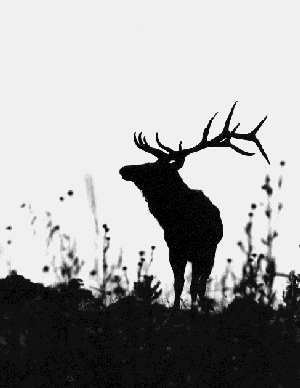Big Game: Early Outlook
by Ed Mitchell
The weather had big game enthusiasts holding their breath for a while but the danger of any widespread winterkill should be past now.

Most of Idaho took a pounding from snowstorms Christmas week. The Panhandle already had substantial snowcover before a week of some of the heaviest moisture in history hit. Coming early and all at once, the big snow could have been tough on wintering game herds, particularly deer and antelope. Hunters began to gather and mutter worries to one another.
Then came the big rain and thaw. (Again, excepting north Idaho where the rain froze on top of the snow and made things even worse.) In most of the state, hillsides bared off in a matter of hours at the elevations big game uses this time of year. Now, we can have more storms but snowcover cannot last long enough to give the herds real trouble.
Animals went into the winter about as fat as they could be. Ample moisture over the last couple of years has continued to rejuvenate range that suffered badly from drought through the late 80s.
My elk, taken in late November, presented a serious fat-trimming job. Most of the other hunters I spoke with mentioned the same phenomenon. These critters have not been wondering about their next meal.
The amount of hard fat big game animals take into the winter is by far the most important factor in their survival. When they carry a lot of it, they can get through some awfully lean times. If they are too trim when winter begins, there is a strong chance they will not see spring even if the winter is not especially tough.
The potentially bleak spot is in north Idaho where deep snows had whitetails yarded up even before the most recent dump of moisture. Yarding hardly ever happens in Idaho and the weather conditions in the north have persisted. We will not know for a while just how bad the effect on whitetail numbers might be but I suspect we can anticipate at least some fawn loss.
Assuming more or less average conditions from this point (the latter end of January), numbers of most big game animals should be at least as good as last fall when we take to the hills again. Hard numbers are not available yet from the biologists. Aerial surveys are being made as we speak and reports will take a little while after they are done. Harvest figures from last fallís deer, elk and antelope hunts come mostly from telephone surveys, a longish process followed by extended number crunching.
Hunter check station reports and field observations do provide some clues and we will go, tentatively, with those for the moment.
Elk. There is no reason to expect any break in the trend of the last several years when numbers and harvest have been at or near historic highs. Warm, dry conditions in the early part of last season made hunting tough but the weather came to the aid of late season hunters.
Mule deer. More four-point-and-better bucks showed up at most check stations last fall and hunters reported seeing more deer than they had the previous two seasons. This reflects the recovery of deer herds hit hard in the winter of 1992-93. (Nature sacrifices the non-essential for the continuation of the species. She saves the mamas to replace the fawns with surprisingly few daddies. Disregarding the tastes of hunters, the bucks go first in harsh times.)
Antelope. Expect only minor changes in herds from last fall.
Permit numbers for moose, bighorn sheep and mountain goats have been set by the Fish and Game Commission. Those numbers are based on the recommendations of game biologists. All of these hunts are controlled by drawing.
Moose. Permit numbers have been raised again. Moose are generally doing well in those limited, but growing, areas of Idaho that have them. A few more antlerless permits will be issued in areas where moose are beginning to cause some problems. Transplants and careful season-setting have paid off for Idaho hunters. Only Idaho residents or former residents with lifetime licenses may hunt moose.
Bighorn sheep. It is a mixed bag. Rocky Mountain bighorns in certain areas have suffered losses from disease. Permits were trimmed. California bighorns that inhabit Owyee County have been doing well enough that a few more permits will be issued.
Mountain goat. The news is a little better for Idahoís goats after years of decline. The slide continues in limited areas of north Idaho where a couple of hunts were eliminated for this year. The overall number of permits was raised slightly but remains a small handful. Transplants are paying off slowly.
For those who wonder why, if prospects are just peachy, there is active discussion about changing deer and elk hunting in Idaho fairly radically: donít worry about this fall. No big changes are in the works for 1997. The changes that do take place will be the result of attempting to keep a good thing good rather than waiting for a crisis, as some of our neighbors did. This is the subject for another article in the near future.
|
